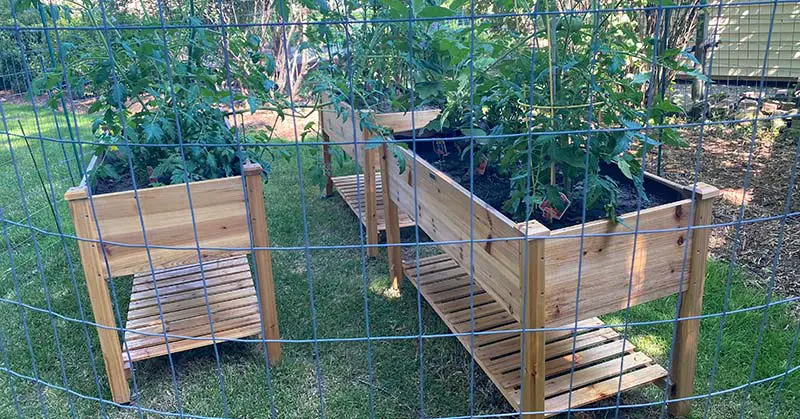Rolling Raised Garden Beds: The Ultimate Guide
“Rolling Raised Garden Beds” are a revolution in modern gardening, combining the benefits of traditional raised beds with added mobility. These innovative structures bring gardening to a whole new level, literally and metaphorically, by lifting your plants off the ground and providing the flexibility to move them as needed.
So whether you’re an urban gardener trying to maximize limited space, a green enthusiast looking to ease the physical strain of traditional gardening, or simply someone seeking a versatile, attractive solution for cultivating plants, rolling raised garden beds might be just what you’ve been looking for.
Join us as we delve into the world of these mobile gardens, exploring their advantages, types, setup, maintenance, and much more.
Explanation of the Concept of “Rolling Raised Garden Beds”
Rolling raised garden beds, as their name suggests, are a type of raised garden bed that incorporates a mobility feature, typically casters or wheels, that allows them to be moved around as needed. This design offers the benefits of standard raised garden beds – improved soil conditions, better drainage, ease of maintenance, and a more comfortable working height – while providing flexibility to move the bed for various reasons.
Constructed from various materials such as wood, metal, or plastic, these garden beds are essentially large boxes or planters mounted on wheels. They come in multiple sizes and designs, suitable for plants ranging from flowers and herbs to vegetables. The addition of wheels can help address several gardening challenges.
For instance, if you live in an area with limited sunlight, a rolling bed allows you to move your plants to take advantage of the changing sunlight throughout the day. They can also be moved indoors in harsh weather conditions or rolled out of the way when you need to use your outdoor space for other purposes.
Moreover, they offer easier accessibility for gardeners with mobility issues, as they can be moved closer for tending, watering, or harvesting.
Overall, rolling raised garden beds takes the convenience and advantages of traditional raised beds a step further, making gardening even more adaptable and accessible.

Benefits of Rolling Raised Garden Beds
Rolling raised garden beds offer several key benefits that make them a valuable asset for both novice and experienced gardeners:
Mobility: The most significant advantage of these garden beds is their mobility. They can be easily moved around to accommodate changing sunlight patterns and weather conditions or even reconfigure outdoor space.
Improved Sunlight Exposure: As sunlight conditions change throughout the day, the mobility of rolling raised garden beds allows for maximizing sunlight exposure for the plants. This can be particularly beneficial in spaces that do not receive consistent sunlight throughout the day.
Ease of Maintenance: The raised design of these beds makes tasks like planting, weeding, watering, and harvesting much easier on the body, reducing the need for bending or kneeling. This makes them especially beneficial for elderly gardeners or those with physical limitations.
Better Soil Control: Like traditional raised beds, rolling versions give you complete control over the soil, allowing optimal conditions tailored to your specific plants. This can be a significant advantage in areas with poor native soil or urban environments where soil contamination could be a concern.
Space Efficiency: These beds are an excellent solution for those with limited gardening space, such as balconies, patios, or urban dwellings. Their mobility allows you to move them out of the way when not in use or to reconfigure your garden layout as needed.
Weather Protection: The mobility of these garden beds allows you to move them indoors or under cover during harsh weather conditions, protecting sensitive plants.
Pest Control: Raised garden beds can help deter some pests, and the mobility factor of rolling beds can add another level of protection. If an area becomes infested, the bed can be moved away from the problem zone.
Versatility: They offer a stylish and versatile solution to grow various plants, including vegetables, herbs, flowers, or even small trees.
Accessibility: For those using wheelchairs or gardeners who prefer not to bend down, rolling raised garden beds can be designed to an appropriate height for easy access.
Why Choose a Rolling Raised Garden Bed?
Choosing a rolling raised garden bed can offer a multitude of benefits to gardeners of all experience levels for a variety of reasons:
Versatility and Adaptability: If your gardening space has varying sunlight exposure throughout the day, a rolling bed allows you to move your plants to take full advantage of the available light. This versatility extends to changing seasons – you can shift the beds around to protect your plants from harsh weather.
Optimal Space Utilization: If you have limited gardening space, such as in an urban setting or a small balcony, rolling raised beds allow you to utilize your space efficiently. You can move them out of the way when you need the space for other purposes.
Better Ergonomics: The elevated nature of raised beds reduces strain on the back and knees, making gardening tasks like planting, weeding, and harvesting more comfortable.
This feature benefits elderly gardeners, people with mobility issues, or anyone who wants to garden without physical strain.
Improved Soil and Plant Health: Similar to traditional raised beds, rolling versions give you complete control over your soil conditions, allowing you to tailor the environment to your plants’ needs. This control over soil quality can lead to healthier, more productive plants.
Control Over Pests and Weeds: Raised beds can help deter certain pests and make weed control more accessible. With rolling raised garden beds, if a pest issue does arise, you can move the bed away from the affected area, adding another layer of protection.
Aesthetically Pleasing: Besides their practical benefits, rolling raised garden beds can also serve as attractive features in your garden, patio, or balcony. They come in various designs and materials, allowing you to match them to your aesthetic preferences and enhance your outdoor decor.
Educational for Kids: These movable beds can also be an excellent tool for teaching children about gardening. Their accessible height and the fun element of being able to move them around can make gardening more engaging for young ones.
Types of Rolling Raised Garden Beds
Rolling raised garden beds come in various types, each with unique advantages. Here are some of the most common types you’ll encounter based on the material, design, and size:
Wooden Rolling Raised Garden Beds: These are the most traditional type and are often made from cedar, which is naturally rot-resistant. Wooden beds have a rustic aesthetic that many gardeners appreciate.
Metal Rolling Raised Garden Beds: Metal beds, often made of galvanized steel or aluminum, are highly durable and long-lasting. They’re also resistant to pests. The metal can absorb heat, which can help to warm the soil in the spring.
Plastic or Resin Rolling Raised Garden Beds: They are typically lighter and more affordable than wood or metal beds. They can resist rot and pests and come in various colors and styles.
Fabric Rolling Raised Garden Beds: Made from durable, breathable fabric, these unique beds provide excellent drainage and can quickly move. They’re also typically easier to store when not in use.
The design of rolling raised garden beds also varies:
Single Tier Rolling Raised Garden Beds: These are the most straightforward design, with a single box or container for planting. They’re great for growing a variety of plants.
Multi-tier Rolling Raised Garden Beds: These have multiple levels or tiers, allowing you to grow different types of plants in the same bed. This design can be a space-saver, and it can also help keep certain plants separated.
Vertical Rolling Raised Garden Beds: These beds are designed to maximize vertical space, making them great for gardeners with limited square footage. They often have shelves or pockets for planting.
In terms of size, rolling raised garden beds range from small, suitable for a few plants or a single type of vegetable, to large, where you can grow a whole vegetable garden. Your size will depend on your space availability, your desire to grow, and how much you can move comfortably.
When choosing the rolling raised garden bed type, consider your specific needs, including your available space, what you plan to grow, your physical ability, and your personal aesthetic preferences.
How to Choose the Right Rolling Raised Garden Bed
Choosing the right rolling raised garden bed for your needs involves several considerations. Here are some factors to think about:
Material: Rolling raised garden beds are typically made of wood, metal, plastic, or fabric. Each has its pros and cons. Wood, for example, has a natural look but can be prone to rot over time, especially if not adequately treated.
Metal is durable and pest-resistant but can be more expensive. Plastic or resin beds are often lighter and more affordable, while fabric beds provide excellent drainage.
Size: Consider your available space and what you plan to grow. You might want a smaller or vertical bed with a small patio or balcony. If you have more space and want to produce a variety of vegetables, a larger bed could be a better fit.
Remember the bed’s weight once filled with soil and plants. Ensure it’s a size you can comfortably move.
Design: Some beds come in single-tier designs, while others have multiple tiers or are designed for vertical planting. If you’re growing different types of plants, a multi-tier or vertical bed could be beneficial.
A single-tier design could be more straightforward and suitable for producing a single crop type.
Mobility: Check the quality of the wheels or casters. They should be sturdy and able to smoothly handle the weight of the bed once it’s filled with soil and plants. Some designs include locking wheels for stability when you don’t want the bed to move.
Depth: The depth of the bed should be suited to what you’re planning to grow. Shallow beds might be suitable for herbs and some vegetables, but if you plan on increasing root vegetables or larger plants, you’ll need a bed with more depth.
Maintenance: Consider how much maintenance the bed will require. Wooden beds may need to be treated to prevent rot, while metal beds can rust over time if not correctly cared for.
Aesthetics: Think about how the bed will look in your space. You might prefer the natural look of wood, the sleek appearance of metal, or the colorful options available with plastic or resin.
Price: Finally, consider your budget. The cost of rolling raised garden beds can vary widely depending on the size, material, and design.
Step-by-step Guide to Setting Up Your Rolling Raised Garden Bed
Setting up a rolling raised garden bed can be exciting and fulfilling. Here is a step-by-step guide to help you get started:
Step 1: Purchase or Construct Your Rolling Raised Garden Bed
Decide on the size, material, and design based on your needs, preferences, and the available space. You can buy a pre-made one or build one yourself if you’re handy.
Step 2: Choose the Right Location
Before filling the bed with soil, decide where it will primarily reside. Remember, one of the advantages of a rolling bed is its mobility, but you’ll still want a primary location with optimal sunlight and a flat surface to keep the bed level.
Step 3: Check the Drainage
Ensure the bed has sufficient drainage holes to prevent waterlogging. You’ll need to drill some in the bottom if it doesn’t.
Step 4: Add a Layer of Landscape Fabric
Cut a piece of landscape fabric to fit the bottom of your bed. This will prevent soil from washing out of the drainage holes while allowing water to drain.
Step 5: Fill Your Bed with Soil
Fill your bed with a high-quality potting mix. If you’re growing vegetables, add a layer of compost or well-rotted manure for extra nutrients.
Step 6: Plant Your Seeds or Seedlings
Follow the planting instructions for your chosen plants regarding depth and spacing. Make sure to water them thoroughly after planting.
Step 7: Position Your Bed
After planting, roll your bed to its chosen location. If your bed is large, you might need help with this to avoid straining yourself.
Step 8: Care for Your Plants
Keep an eye on your plants as they grow. Water and fertilize them as needed, and feel free to roll your bed to a new location if they need more sunlight or if the weather is too harsh.
Step 9: Enjoy the Fruits of Your Labor
When your vegetables are ripe or your flowers bloom, enjoy the satisfaction of growing them yourself in your rolling raised garden bed.
Maintenance Tips for Rolling Raised Garden Beds
Maintaining your rolling raised garden bed properly can help ensure its longevity and the health of your plants. Here are some tips to keep your garden thriving:
Regular Watering: Depending on what you’re growing, your plants will likely need regular watering. Check the soil moisture levels regularly, especially in hot weather. However, avoid overwatering as this can lead to root rot.
Soil Health: Refresh your soil annually by adding compost or other organic matter. This will help maintain soil fertility and structure. Rotate your crops if you’re growing vegetables, as different plants have different nutrient needs and can help prevent the buildup of diseases.
Checking Casters/Wheels: Regularly check the condition of the wheels or casters. Keeping them clean and in good condition will ensure your garden bed remains easy to move.
Plant Health: Keep an eye out for signs of pests or diseases. Early detection can make treatment much more effective. Consider using organic or natural pest control methods to remove harmful chemicals from your soil.
Treating the Material: If your garden bed is made of wood, you should treat it annually to prevent rot and extend its life. Metal beds might need a coat of rust-proof paint every few years.
Winter Care: If you live in a region with harsh winters, consider moving your bed to a sheltered location or covering it to protect the soil and the structure. If it’s a smaller bed, you can move it indoors to continue growing through the winter.
Cleaning: Keep the bed clean. Remove dead plants, leaves, and other debris which could harbor pests or diseases.
Sunlight Rotation: Utilize the mobility feature of the rolling garden bed. Rotate the bed’s position to ensure all plants receive equal sunlight, significantly if growing in a space with partial shade.
Common Mistakes to Avoid
While rolling raised garden beds offer a lot of benefits, there are common mistakes you should avoid to make the most out of your gardening experience:
Poor Placement: Although the beds are mobile, they should still primarily be placed in a location with sufficient sunlight. If your plants aren’t thriving, you may need to move the bed to a sunnier spot.
Insufficient Depth of Soil: Different plants have different root depths. Ensure your bed is deep enough for your growing needs, especially planting root vegetables or larger plants.
Neglecting Drainage: Proper drainage is crucial to prevent overwatering. If your bed needs sufficient drainage holes, it can lead to waterlogged soil and root rot.
Not Checking the Quality of Casters/Wheels: The wheels need to be sturdy enough to handle the weight of the bed with soil and plants. Check this to avoid difficulty moving the bed or potential damage.
Using Poor Quality Soil: The soil quality in your raised bed is crucial for the health of your plants. Use a high-quality potting mix and amend it with compost or other organic matter.
Overcrowding Plants: Giving your plants enough space to grow is essential. Overcrowding can lead to poor air circulation and increased disease pressure. Always follow the recommended spacing for whatever you’re planting.
Neglecting Regular Maintenance: Regular maintenance, including watering, fertilizing, pest control, and checking the condition of the bed and its wheels, is essential for the overall success of your garden.
Ignoring the Weight: Although the bed is mobile, it will be heavy when filled with soil and plants. Avoid overfilling it so it becomes too heavy to move safely and comfortably.
Forgetting to Lock the Wheels: If your rolling bed has locking casters, remember to use them. You don’t want your bed to roll away with a gust of wind or on a slight slope.
Final Thoughts
Rolling raised garden beds offer a flexible and efficient solution to gardening, especially for those with limited space or varying sunlight exposure. They provide numerous benefits, including improved ergonomics, better control over soil and plant health, and effective pest and weed control.
These movable beds come in various materials and designs, and choosing the right one involves considering factors such as size, design, mobility, depth, aesthetics, and maintenance requirements.
Setting up and maintaining a rolling raised garden bed is a fulfilling process that rewards you with a vibrant and productive garden. With the correct setup, choice of plants, and proper care, you can grow a thriving garden regardless of space constraints.
Avoiding common mistakes and practicing regular maintenance ensures your garden bed’s longevity and plants’ health.
A rolling raised garden bed is an innovative gardening solution and an opportunity to cultivate a closer connection with nature right in your backyard, patio, or balcony.



